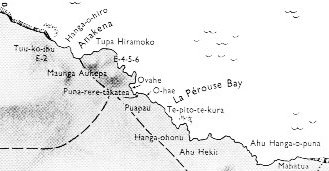1. Once again, these are the 17 glyphs at the
beginning of the G text, and as an exercise I have below added possible
kuhane station 'equivalents', based on my vivid imagination and
earlier
discussions, e.g. from regarding the possible parallels between Ga1-3--4, -6 on one hand
and Eb7-26--27, -29 on the other:
|
24 |
Oromanga |
25 |
Hanga Moria One |
26 |
Papa O Pea |
27 |
Ahu Akapu |
|
birthplace of the new king |
residence of the current king |
residence for the future king |
residence for the abdicated king |
|
28 Te Pito O Te Kainga |
Continuing on we can
see that the last 14 glyphs in line Ga1 are just enough to cover
the remaining kuhane stations in order to reach Oromanga, where the next Sun king will be born:
 |
 |
 |
 |
 |
 |
|
Ga1-17 |
Ga1-18 |
Ga1-19 |
Ga1-20 |
Ga1-21 |
Ga1-22 |
|
Maunga Teatea (?) |
Mahatua (?) |
Taharoa (?) |
 |
 |
 |
 |
 |
 |
 |
 |
|
Ga1-23 |
Ga1-24 |
Ga1-25 |
Ga1-26 |
Ga1-27 |
Ga1-28 |
Ga1-29 |
Ga1-30 (31) |
|
Hanga Hoonu (?) |
Rangi Meamea (?) |
Peke Tau O Hiti (?) |
Maunga Hau Epa (?) |
With 31 glyphs before Ga2 it is impossible to have 2 glyphs per
station all through line Ga1, and 31 - 5 = 26 is a nice number
which becomes 13 pairs. 31 = 5 + 2 * 13. Our curiosity forces us
to look for the kuhane stations before Te Pei at
the end of line Gb8:
In Gb8-24 a strange figure
(with short wings like those of the 'insect in amber',
Ga1-16) is looking back, which must mean day number 466 (= 366 +
100) is a day of finality:
|
 |
6 |
16 |
 |
|
Gb8-24 |
Ga1-16 |
The result of multiplying 11 * 6 = 66 (in
Ga1-16) could
be a hint that we should search for glyph number 66 beyond
400.
From Maunga Teatea the
kuhane of Hau Maka looked ahead to Rangi Meamea:
... Everywhere the
dream soul looked around for a residence for the king. The dream
soul went to Maunga Teatea and gave him the name 'Maunga
Teatea A Hau Maka O Hiva'. The dream soul of Hau Maka
looked around. From Maunga Teatea she looked to Rangi
Meamea (i.e., Ovahe).

The kuhane identified
Maunga Teatea with a male person, and the name fits well
with Saturn, because teatea should be the opposite of
tea. Black, the absence of light, the 'colour' of Saturn, is
the opposite of white.
On Makoi's list the
number for Maunga Teatea is 25 (a Saturn number), and on page 39 of
Manuscript E the last item (though overcrossed) is 31:
|
39) |
|
14 |
hatu
ngoio
a taotao ika. |
|
15 |
ara
koreu
a pari
maehaeha. |
|
16 |
hanga
kuokuo
a vave renga. |
|
17 |
Opata
roa
a mana aia. |
|
18 |
vai tara
kai u(a) a ngao roaroa a ngao tokotokoa. |
|
19 |
hia uka
a hakairiiri a hakaturuturu. |
|
20 |
hanga
ohiro
a pakipaki renga. |
|
21 |
ko
roto kahi
a touo renga. |
|
22 |
ko
papa kahi
a roro. |
|
23 |
ko
puna a tuki
a hauhau renga |
|
24 |
ko
ehu
ko mahatua a piki rangi a hakakihikihi mahina |
|
25 |
ko
maunga teatea
a pua katiki. |
|
26 |
ko
te hakarava
a
hakanohonoho. |
|
27 |
ko
hanga nui
a te
papa tata ika. |
|
28 |
ko
tongariki
a henga eha tunu kioe hakaputiti.ai |
|
|
ka haka
punenenene henua mo opoopo o tau kioe |
|
29 |
ko
te rano a raraku. |
30 |
ko
oparingi
a a uuri |
31 |
ko
motu kumu
koka a
kaoa |
This fact should make us
consider 'overcrossing' the last 4 glyphs in line Ga1:
 |
 |
 |
 |
|
Ga1-27 |
Ga1-28 |
Ga1-29 |
Ga1-30 (31) |
|
Peke Tau O Hiti (?) |
Maunga Hau Epa (?) |
And then there will be only 10 glyphs (5
stations) remaining beyond the cardinal point of Pua Katiki:
 |
 |
 |
 |
 |
 |
|
Ga1-17 |
Ga1-18 |
Ga1-19 |
Ga1-20 |
Ga1-21 |
Ga1-22 |
|
Maunga Teatea (?) |
Mahatua (?) |
Taharoa (?) |
 |
 |
 |
 |
|
Ga1-23 |
Ga1-24 |
Ga1-25 |
Ga1-26 |
|
Hanga Hoonu (?) |
Rangi Meamea (?) |
Furthermore, we should also consider other
structures discovered earlier, e.g.:
|
39) |
|
14 |
Hatu
Ngoio |
17 |
Opata Roa |
27 |
Hanga Nui |
|
15 |
Ara
Koreu |
18 |
Vai
Tara |
28 |
Tongariki |
|
16 |
Hanga Kuokuo (20) |
19 |
Hia
Uka |
29 |
Te
Rano A Raraku |
| |
20 |
Hanga Ohiro |
30
|
Oparingi |
|
21 |
Roto
Kahi |
31 |
Motu Kumu (36) |
|
22 |
Papa
Kahi |
|
|
23 |
Puna
A Tuki |
|
24 |
Ehu |
|
25 |
Maunga Teatea |
|
26 |
Te
Hakarava (31) |
|
38) |
130 |
Te
Hereke (17) |
40) |
350 |
Te
Pipi Horeko (41) |
|
39) |
260 |
Te
Hakarava (31) |
41) |
500 |
Hanga
Te
Pau (60) |
|
290 |
Te
Rano A Raraku (35) |
560 |
Te
Vai Rutu Manu (71) |
We have now (tentatively) reduced 31
glyphs in line Ga1 to 5 + 6 + 5 = 16 'stations',
which we can imagine as a sign of the 16th station
Hanga Takaure, the end of 'winter'.














